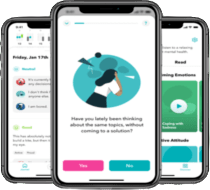Hip pain treatment online | Online Physiotherapy Clinic
- Affordable and reliable Hip pain treatment
- Video sessions with expert Physiotherapists/ PTs.
- Specialized physical therapy for Hip pain, sprain, bursitis, or stiffness
Begin Therapy
Consult online with best Physios
A New Model for Hip Pain Treatment
We understand that it’s difficult for most of us to find time for traditional Hip physical therapy. Physio Mantra brings to you online Knee pain treatment, where all Hip exercises and treatments are managed through regular online check-ins & video sessions.
Expert Physical Therapists
Physio Mantra members get matched with a professional physiotherapist for one-on-one Hip pain treatment. They use interactive exercise videos available on our app to treat you.
Continuous Medical Care
Physio Mantra physiotherapists are 100% virtual and provide physical therapy to patients without any time and geographical barriers. Our technology-enabled approach helps manage physical ailments from head to toe.
Personalized Hip Therapy
Physio Mantra provides everyday exercises, home remedies, and regular check-ins for all your Hip pain physiotherapy needs. We individualize treatment for each person, with problems including Hip pain, muscle injuries, sprain, bursitis, stiffness, and more.

Best Hip Pain Clinic, Now In Your Pocket
Our physical therapists or PTs are available in all parts of the world via an easy-to-use mobile application. The use of artificial intelligence, and data science enables the patients to connect with expert physiotherapists and get real-time insights into their Hip health. Download PhysioMantra App Now

How it works

Signup for Hip Treatment Program
Just fill up a 5-minute online form to tell us about your Hip pain history and treatment expectations.

Meet your PT
We will connect you with a physiotherapist who is available 24/7 to you via call or chat.

Connect to our app
Get Physical Therapy sessions on our app via video calls. Follow exercises suggested by our PT and track your progress in the app.
Meet the best online physical therapist
MantraCare physical therapists treat muscle and joint pain problems through a combination of body exercises, video demonstrations, and a healthy diet. Our treatment experience is a better traditional in-person approach in multiple ways.

Dedicated Physio
You get a personal Physio who customizes the exercise plan based on your comfort and needs

App-guided Exercises
3D animations & voice narrations in our app ensure proper and right guidance

Expert care anywhere, anytime
With over 200+ physios, MantraCare is 100% online – no waiting rooms

Exercise Kit
Complete exercise kit with elastic bands, door anchor, and a phone stand – mailed to you
A Complete Guide About Hip Pain Physiotherapy
Understanding Hip Pain
Hip pain is a broad term that can refer to many different problems. When most people think of hip pain, they typically think of the ball-and-socket joint between the femur and pelvis. However, there are other areas around the hip that can cause pain as well. The sciatic nerve runs down your leg from your spine; if this nerve becomes compressed, it can cause pain in your hip. Other causes of hip pain include arthritis, bursitis, and iliotibial band syndrome.
Sometimes hip pain is caused by a problem in another part of your body. For example, you may have lower back or knee problems that cause hip pain. It’s always best to see an experienced physical therapist or other health care professional for an assessment and treatment plan tailored specifically to your needs.
Types of Hip Pain
There are many different types of hip pain. Some are caused by the joint itself, while others may be due to problems with other parts of your body that affect the hip area.
Acute Pain
Acute pain is sometimes called “new” pain. It is usually caused by an injury or some sort of sudden event. This type of pain is often sharp and intense, and it lasts for a relatively short period of time. This type of pain usually responds well to treatment.
Chronic Pain
Chronic pain is the opposite of acute pain. It is usually caused by a problem that has been present for a long time, and it often continues even after the initial injury has healed. This type of pain can be very frustrating and difficult to treat.
Nociceptive Pain
Nociceptive pain is caused by damage to tissues in your body. The sensation of this type of pain is usually described as throbbing, burning, or aching. Nociceptive pain is the most common type of hip pain.
Neuropathic Pain
Neuropathic pain is caused by damage to nerves in your body. The sensation of this type of pain can be described as burning, tingling, sharp, or electric. Neuropathic pain is less common than nociceptive pain, but it can be very severe.
Signs of Hip Pain
There are many signs of hip pain. Some of these are:
Limping
Limping is a common sign of hip pain. It may be due to damage to the joint itself or to other parts of your body that affect the hip area. This also applies to walking in a way that puts less weight on one side of your body than the other.
Pain with Movement
Another common sign is pain when moving your hip or leg. You may have difficulty sitting down, standing up, squatting, or going from lying to sitting positions. This type of pain often occurs because the muscles and tendons around your hips are tight and inflamed due to overuse or injury; however, it could also be caused by arthritis in your joints (including osteoarthritis) or degenerative disc disease.
Pain at Night
Some people experience pain only when they’re sleeping. Others have trouble falling asleep because their hips hurt too much for them to lie comfortably on either side; this can
Hip Pain When Walking
If you experience pain when you walk, it is likely that the problem is located in your hip joint. This type of pain often gets worse over time.
Pain In Groin Area
The groin area is a common site for hip pain. This may be due to problems with the muscles and tendons in this area, or with the joint itself.
Fever
If you have a fever along with your hip pain, it could indicate an infection or inflammation of the joint itself. If this is happening to you, seek medical attention immediately!
Hip Pain When Squatting
If you experience hip pain when squatting, it’s likely that there’s something wrong with either your knees (if they hurt too) or feet (if they feel weak). It could also be caused by tightness in your quadriceps muscles and/or tendons around them (quadriceps tendinitis), which can pull on the bones below causing irritation there as well.
Causes of Hip Pain
There are many causes of hip pain. Some of these are:
Physical Injury
A physical injury is the most common cause of hip pain. This type of pain can range from mild to severe, depending on how much damage has been done and where it happened in your body. It may be caused by overuse or trauma during activity such as running or lifting heavy objects incorrectly; however, even falling on a hard surface at just the right angle could also cause enough damage that you feel some discomfort when moving around too much.
Medical Conditions
Sometimes hip pain is caused by a medical condition such as arthritis, bone cancer, or an infection in your joint. If this is happening to you, it’s important to seek out professional treatment immediately so that these problems can be treated appropriately before they become worse over time.
Arthritis
Arthritis is the most common cause of hip pain in older people. It causes inflammation and stiffness which makes moving around difficult if not impossible at times.
Infection in Your Joint
An infection can also occur inside the hip joint itself. This is a serious problem that can cause a lot of pain, swelling, and redness in the area. It requires immediate medical attention!
Bone Cancer
Hip pain may also be caused by bone cancer. This is an unfortunately common condition, but it’s important to remember that there are many treatments available that can often result in a full recovery.
Degenerative Disc Disease
Degenerative disc disease is another possible cause of hip pain. In this condition, the discs between your vertebrae gradually wear down over time, leading to inflammation and pain in the surrounding areas including your hips.
Treatment Options For Hip Pain
There are many different types of treatment for hip pain depending on what is causing it. In some cases, you will need to rest and avoid activity that makes your symptoms worse until they go away on their own (this could take several weeks or months). Other times surgery may be required if there is damage inside the joint itself such as an infection or bone cancer (but these situations are rarer than other types of hip pain)
Physical Therapy
A physical therapist can help you strengthen the muscles around your hips so they’re less prone to injury. They’ll also give advice about how best to exercise without straining them further by doing exercises incorrectly – which will only make matters worse in many cases! These professionals may suggest stretches too that might ease stiffness caused by sitting down all day long at work, for example.
Medication
There are many different types of medications that can help relieve hip pain, depending on what is causing it. These might include over-the-counter ibuprofen or naproxen, prescription painkillers such as codeine or oxycodone, or corticosteroid injections directly into the joint itself to reduce inflammation.
Physiotherapy For Hip Pain
Physiotherapists can provide treatment through exercise, massage, and manipulation of joints to help alleviate symptoms associated with arthritis or other causes of hip pain. In some cases they might even use electrical stimulation where they’ll apply an electric current near nerve endings at specific points on your body that may have become hypersensitive due to injury – this helps relieve discomfort so you feel more comfortable when moving around again.
Types of Physiotherapy For Hip Pain
There are many types of physiotherapy for hip pain, depending on the cause of it. Some of these are:
Exercises
Exercises are a great way to treat hip pain. The most common exercise that is recommended by physiotherapists is stretching exercise which can help relieve stiffness in joints, reduce muscle tension and improve range of motion around the affected area so it becomes less painful when moving again. Physiotherapists also use strengthening exercises as well such as using resistance bands or weights machines at home to build up strength around their body parts where they feel discomfort from arthritis or overuse injuries like tendinitis in their hands or knees (for example).
Massage Therapy
Massage therapy is another popular treatment for hip pain, particularly when used in conjunction with physiotherapy exercises. The most common type of massage that physiotherapists use on patients suffering from arthritis involves kneading pressure points around their body along with stretching out muscles through various movements like squats or lunges before applying more intense pressure directly onto any areas where there is particularly bad inflammation or stiffness.
Manual Therapy
Manual therapy involves using hands-on techniques to treat hip pain. Physiotherapists usually use their fingers and thumbs during manual therapy treatments, but they can also use other tools such as heated stones or soft massage balls if needed. The most common types of manual therapy include joint mobilizations (gentle stretching movements) and manipulation (quick thrusts into tight muscles).
Benefits of Physiotherapy For Hip Pain
There are many benefits of physiotherapy for hip pain, and it can help relieve symptoms such as stiffness or soreness that are often associated with arthritis. Physiotherapy also helps improve the range of motion in joints so they work better again after an injury like a sprained ankle or fractured bone – this means people will feel less pain when moving around once their muscles have been stretched out properly using these techniques.
10,000+ Happy Wrist Pain patients from the world

“I was suffering from terrible hip pain for several months before I decided to go and see a physiotherapist. They recommended some simple exercises to do at home, as well as joint mobilizations and manipulation which really helped to relieve the stiffness and soreness in my hip. After a few sessions, my hip was feeling much better and I could move around without any discomfort. Thanks, PhysioMantra for your help.”
John, 6 Months at MantraCare
Best physiotherapist from across the world





We treat nearly all muscle and joint issues
Not all physical or muscle problems are the same. Different types of problems require different treatments. At MantraCare, 200+ physical therapist the world cover a range of specialties to meet your needs be it back pain, shoulder pain, or sports injury:
Frequently Asked Questions
Yes! Hip pain is not just experienced during the day. It can be present at night too, but usually only if you’re sleeping on an uncomfortable mattress (or even one that isn’t supportive enough). This type of sleeping surface tends to put pressure points where there shouldn’t be any – meaning when lying down for a long period of time, it’s likely that you’ll develop aches and pains around those areas from being in one position all night.
The most common cause is arthritis or other conditions like bursitis that lead to inflammation in the joint itself (where two bones meet). Other factors include an injury sustained during sports activities such as running or playing football/basketball – but there are also many less obvious reasons why someone might experience discomforting symptoms in this area including poor posture while sitting on a chair all day long with bad ergonomics.
The cost of physiotherapy for hip pain varies depending on the clinic you attend and your insurance coverage. However, it’s usually a relatively affordable treatment that can be spread out into monthly payments if needed. Many clinics also offer package deals that can work out to be cheaper in the long run.
There are many different types of exercises that you can do at home for your hip pain. Physiotherapists will often prescribe stretching exercises (especially if you have arthritis) as this helps to improve range of motion and reduce stiffness around the joint. Strengthening exercises using weights or resistance bands are also beneficial, especially if you’re trying to rehab an injury. Finally, balance exercises can help improve your stability and prevent falls in the future.
Yes! Physiotherapy is often recommended for people who have had hip replacement surgery, as it can speed up the healing process and help reduce inflammation and swelling around the joint. It’s also a good way to maintain strength and mobility in the operated area, which is crucial for preventing any long-term problems after the surgery has been completed.










